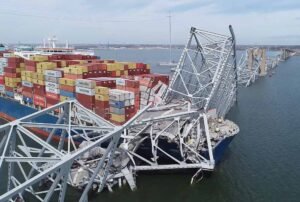
Editors’ note: This article is from Nonprofit Quarterly Magazine’s fall 2023 issue, “How Do We Create Home in the Future? Reshaping the Way We Live in the Midst of Climate Crisis.”
The climate plan (or Scoping Plan) that California passed in December 2022 was full of praise for the environmental justice (EJ) community.1 This was a very different tune from that of the first climate plan, in 2008, when the conflict between the California Air Resources Board (the state climate agency) and the Environmental Justice Advisory Committee (the state’s official climate advisory body) led to EJAC members filing a lawsuit against the state for environmental racism.2 Through 15 years of developing more sophisticated climate justice policies and advocacy strategies, the California EJ movement’s climate leadership is shining.
Culture Shift
We knew that real climate solutions had to come from Black people, Indigenous people, people of color on the ground who had firsthand experience with climate impacts and could propose solutions that would meet this existential challenge.
I don’t believe that White people are going to save us. I didn’t believe it before and I don’t believe it now, with the climate crisis. I’ve seen colonizers decimate our people, from Asia to the Americas. The Principles of Environmental Justice3 call on us who have survived hundreds of years of colonization to raise our leadership and develop solutions in the long arc of our liberation. We work best with folks who come in solidarity for our joint liberation; so it was natural to be skeptical of White climate scientists and environmental policy wonks who were selling climate policies riddled with harms to low-income communities of color. Early policymakers pushed pollution-trading schemes that would concentrate emissions in our neighborhoods at the fenceline of oil refineries and dirty gas power plants. Their early action programs subsidized solar panels and electric cars for rich White households, and left out communities of color economically. We weren’t buying it.
We knew that real climate solutions had to come from Black people, Indigenous people, people of color on the ground who had firsthand experience with climate impacts and could propose solutions that would meet this existential challenge. And besides, White climate activists were losing the national political battle and they needed BIPOC power to win.4 So, EJ organizers charted a new path for climate justice policy that fundamentally altered the California political landscape.
Similar to the early EJ movement’s redefinition of environmentalism to be more holistic than the 1970s environmental movement frame of resource conservation (“save the trees,” “save the whales”), California EJ groups reframed climate problems and solutions to a frame articulating that we also had to save the people dying from the causes and catastrophes of climate change. True to community organizing, we found entry points for everyday people to see themselves in the dialogue. Academic friends published the report The Climate Gap: Inequalities in How Climate Change Hurts Americans & How to Close the Gap,5 which helped to mainstream our perspective: we knew the problems of air pollution in our neighborhoods that caused asthma in our kids; we experienced grocery and utility bills skyrocket when climate disasters hit; we felt the forced migration of our global families due to storms, floods, and fires. These experiences also meant that frontline communities were already developing solutions to deal with the crises: pollution controls on oil refineries and industrial sources, localizing and democratizing food and energy resources, and tools identifying the zip codes and census tracts of the communities most vulnerable to climate change, so that we could target support for them.
I wish I could tell you that our climate solutions were met with open arms by established climate experts in the early 2010s, but instead they lashed back with condescension, saying to EJ leaders that we didn’t know what climate policy was about. Whether it was their overt racism or microaggressions, we clashed. Their carbon fundamentalism would tell us that our solutions to reduce air pollution were too broad because climate change was about carbon dioxide. (Read more on problematic narrow frames of carbon and climate in Shalanda H. Baker’s Revolutionary Power and Michael Méndez’s Climate Change from the Streets.6) Heads of climate programs told us to wait for the trickle-down effect, after they funded rich folks to slap solar panels on their roofs and buy Teslas. Environmental policy wonks said it was outside of the climate frame to claim that affordable housing next to bus lines would reduce transportation emissions.7 State agency leaders said not to mess with their climate fund, which gave away millions to the biggest industries under free carbon permits, and that they didn’t want to dedicate funds to EJ communities for our climate projects.8 Well, that all turned around with EJ organizing.
BIPOC organizers envisioned how EJ could live and thrive in government planning to meet climate goals. Mostly, we had to turn the White heads of agencies and governments to look at the California we knew: over 50 percent people of color. BIPOC are the majority of our state.9 We made them see where the millions of EJ communities are, and how our cumulative impacts work on the Environmental Justice Screening Method highly influenced the design of CalEnviroScreen,10 released in 2013 and which over time has directed billions of dollars for California climate investments.11 We forced them to recognize that EJ communities were essential rightsholders in climate planning. See the EJ sections and notes on the committee (EJAC) that became formalized in California’s first major climate law: 2006, Núñez, the AB 32 Global Warming Solutions Act. This climate bill failed the first time but passed the next, thanks to Latinx caucus voters who insisted on the inclusion of EJ.12
We grew champions from the community and legislature to run state bills and take seats of power in the 2010s, including dedicating EJ board seats and EJ staff at the CARB climate agency.13 Educating and partnering with legislators from the California Latino Legislative Caucus,14 California Asian American & Pacific Islander Legislative Caucus,15 and California Legislative Black Caucus,16 EJ helped reframe climate policy, including: SB 535 (2012, de León, climate investments to benefit disadvantaged communities);17 SB 605 (2014, Lara, reduction of super-pollutant emissions like black carbon from diesel trucks);18 AB 197 (2016, E. Garcia, prioritizing direct emissions reduction);19 AB 617 (2017, C. Garcia, community emissions reduction);20 and the valiant introduction of AB 1839 (2020, Bonta, California Green New Deal), which unfortunately failed to pass.21 And across the national EJ and climate justice movement, we were coalescing our stories and strategies for a Just Transition,22 to move us away from an extractive economy that depletes our labor and energy and toward a future of building new local living economies with our hands. If a solution doesn’t include EJ communities in governance, ownership, and benefits, it’s not a real solution.
Fossil Fuel Phaseout
I write this section sitting, with my laptop, in a Richmond, CA, park overlooking the blue waters of the Bay—waters flowing through the Golden Gate Bridge toward the Chevron Richmond Refinery that has disfigured a hill with big oil tanks and towers of smokestacks. It wasn’t always like this. Standard Oil took over this scenic land in the Bay Area more than 100 years ago and expanded oil refinery operations like Chevron Corporation, which we now know as the single biggest source of greenhouse gas emissions in California.23 Back in time, I imagine the natural state was hills dotted with oak trees and waters teeming with abalone that the Ohlone people stewarded. And if I dream the dream of Black, Latinx, and Asian youth organizers of Richmond, I see a future home and economy for them that has decommissioned the oil industry and replaced it with local businesses and parks that can sustain them. This dream is part of how EJ groups are writing climate policy and writing the end of fossil fuels that cause global warming.
The mother of California’s climate laws, AB 32 aims to reduce greenhouse gas emissions by 80 percent of our 1990 emission levels by 2050.24 (OK, that was wonky.) What this means is that California’s economy, the fifth largest in the world, has to clean up and shift its economy from polluting cars, factories, electricity, and buildings to running on clean energy and zero-emission sources. It’s an immense pivot—it doesn’t happen overnight. There are competing ideas. Old—dinosaur—businesses vehemently resist this change. Oil and gas companies that account for more than half of California’s climate pollution spend tens of millions a year to lobby against our climate bills and programs.25 Frustratingly, climate staff at the state agencies were and are slow to act and have even resisted EJ ideas. And we have to meet our climate targets.
I think of Hurricane Katrina in 2005, and the Black folks who didn’t make it out of the floods. I think about the conditions that worked against them being able to survive, and their echoes in American city planning, which has segregated neighborhoods by race and class and by desirable versus inhospitable locations.
In 2021, CARB staff’s first proposed climate Scoping Plan to meet California’s 2045 emission reduction goals was terrible for EJ, because they ignored the top EJ recommendations from the last Scoping Plan that not only reduce climate pollution directly but also protect EJ communities. But then they had to convene the EJAC to advise them (as written in the AB 32 law). (Ha!) Agency staff who have historically spent a lot of time with industry lobbyists now had to spend a lot of time with EJ leaders for the Scoping Plan process. The staff approach to give the fossil fuel industry more time to follow the law, more funds and allowances to convert, and more accounting tricks to meet the climate targets was a tired set of climate programs that EJ communities didn’t want to see again.26 Could CARB practice that giving approach to the most impacted and vulnerable communities instead? The EJAC and EJ groups proposed stricter scenarios to meet reductions in multiple sectors of the economy, including petroleum refining. Decades of fighting these fossil fuel fools in our communities through science, organizing, and lawsuits informed our climate policy recommendations. The EJAC also brought CARB staff and board members to visit EJ communities at the fenceline of these massive oil refineries and dirty gas-fired power plants so they could get a taste of the struggle and need to wind down these industries. And after nearly two years of the Scoping Plan drafting and debating (the final, 2022 plan is the fourth update), EJ groups won a commitment for the phasedown of oil and gas extraction and refining with an interagency process to coordinate this plan.27
Sign up for our free newsletters
Subscribe to NPQ's newsletters to have our top stories delivered directly to your inbox.
By signing up, you agree to our privacy policy and terms of use, and to receive messages from NPQ and our partners.
Clean Transportation for the Masses
I think of Hurricane Katrina in 2005, and the Black folks who didn’t make it out of the floods. I think about the conditions that worked against them being able to survive, and their echoes in American city planning, which has segregated neighborhoods by race and class and by desirable versus inhospitable locations—and those places where investments are supposed to go but never arrive, including in transportation. Coming from a low-income immigrant family, I knew the struggles of saving up enough money from low wages to own a car. Taking the bus was better, and it was familiar to me, since the Philippines had great public transit by colorful jeepneys and buses. I saw folks of color, grandmas and students, have a kinship on the bus. And this was an unrecognized form of environmentalism that EJ groups fought to include as a climate solution.
Transportation emissions account for 40 percent of California’s climate problem.28 From the northern Klamath River Tribes to Barrio Logan in San Diego on our southern border with Mexico, California is over 800 miles long. Car culture was peddled by oil companies to great success, breaking down public transportation systems. We lose a lot of time stuck in traffic. Our long coastline has invited trade and the building of major ports for goods that haven’t been good for our lungs, because they involve living with nearly two million diesel trucks. So when early climate policy advocates told us we were going to be saved by electric cars, you can imagine that we EJ folks rolled our eyes!
I want to enjoy summer, but being a climate activist, I’m aware of the dangers that lurk when you mix rising temperatures, drier landscapes, higher energy use for air conditioners, skyrocketing utility bills, failing transmission lines, and the dirtiest gas power plants fired up for the power hungry.
EJ climate solutions to California’s transportation problem involve prioritizing pollution reduction from diesel trucks; promoting affordable housing at bus and train hubs; improving and providing free transit passes, clean school buses, and public shuttles across rural areas; and land use planning to improve air quality and prevent displacement—all, under the technical term vehicle miles traveled (VMT), to reduce transportation emissions.29 We weren’t opposed to electric cars if the state subsidized lower-income households with incentives and built car-charging infrastructure in our neighborhoods (the state has decent plans for this equity program, now).30 These are EJ lived experiences, and our proposals for the state to use its authority to influence local regions and municipalities to get on board in doubling the state’s target for VMT reduction was one of the EJ policy wins in the Scoping Plan.
Grid of the Future
I want to enjoy summer, but being a climate activist, I’m aware of the dangers that lurk when you mix rising temperatures, drier landscapes, higher energy use for air conditioners, skyrocketing utility bills, failing transmission lines, and the dirtiest gas power plants fired up for the power hungry. The last several summers in California saw the worst wildfires, drought, and power shutoffs we’ve ever experienced. Most of the catastrophes were attributed to corporate utility mismanagement, especially Pacific Gas & Electric sparking the biggest wildfires California has ever seen and cutting off disabled people’s electricity. To make matters worse, Governor Newsom waived pollution-control laws to “keep the lights on”—to the immediate detriment of EJ communities living next to dirty gas plants (read the EJ report, California’s Underperforming Gas Plants31). Plus, there are the longer-term dangers of keeping nuclear plants open beyond retirement dates. It’s a mess: people are trying, and dying, and we need a way out. And this isn’t just happening in California.
I have more battle stories to tell, as desperate ideas pop up from dying industries or White supremacy rebranding itself as climate policy.
The zen part of me says we have everything we need—we just have to organize our way through chaos: aging infrastructure, politicians in the pockets of corporations, policy frenemies. I remind myself that we got damn good energy laws passed, like SB 100 (2018, de León) to power the state with 100 percent clean renewable energy by 2045,32 and AB 693 (2015, Eggman), $1 billion for solar on multifamily affordable housing that allow renters to benefit from solar programs.33 As the California Air Resources Board looked at 2045 climate targets, however, they first proposed building new fossil gas power plants to get there. (What?! Absurd!) An EJ battle ensued. The big EJ and big green partnership under the Regenerate California campaign to retire the 200 gas power plants in the state got organized with the EJAC—and victoriously convinced the state to eliminate any new gas-fired electricity generation in the 2022 Scoping Plan.34
Fight the bad and build the new are two main gears of the Just Transition strategy. Fight bad power plants: check. Build new clean energy: check. We also need to localize, own, and govern our energy system. These are significant parts of our vision for the energy grid of the future. Campaigns are underway calling for local clean energy (“distributed energy resources”), energy democracy (including community- and worker-controlled utilities), and community resilience (safe hubs with microgrids, food, and water). There’s people power actively engaged in policy and decision-making spaces to keep moving us toward the new energy system we need.
***
I have more battle stories to tell, as desperate ideas pop up from dying industries or White supremacy rebranding itself as climate policy. It’s taken many years of grit serving on the EJAC, advocating with community members in the halls of the state capitol, and building bridges to get here to tell these climate justice wins. I suffer from climate grief and anxiety too, like our youth, who are bombarded with apocalyptic stories. And I feel more alive in community with organizers and artists, choosing to write our destiny. I’m grateful to be part of the leadership of the California Environmental Justice Alliance, building power among the 10 biggest base-building EJ organizations in the state, to make these climate policies take root and bloom on the ground so we are able to weather the storms.
Notes
- “Meeting: State of California Air Resources Board, California Environmental Protection Agency,” December 15, 2022, ww2.arb.ca.gov/sites/default/files/barcu/board/mt/2022/mt121522.pdf; and “2022 Scoping Plan Documents,” California Air Resources Board, accessed July 25, 2023, ww2.arb.ca.gov/our-work/programs/ab-32-climate-change-scoping-plan/2022-scoping-plan-documents.
- Cara Horowitz, “Calif court tentatively rules AB 32 implementation unlawful,” Legal Planet, February 2, 2011, legal-planet.org/2011/02/02/calif-court-tentatively-rules-ab-32-implementation-unlawful/.
- “The Principles of Environmental Justice: Drafted and Adopted by the First National People of Color Environmental Leadership Summit in 1991 in DC,” Climate Justice Alliance, accessed July 25, 2023, climatejusticealliance.org/ej-principles/.
- Daniel J. Weiss, “Anatomy of a Senate Climate Bill Death,” Center for American Progress, October 12, 2010, www.americanprogress.org/article/anatomy-of-a-senate-climate-bill-death/.
- Rachel Morello-Frosch et al., The Climate Gap: Inequalities in How Climate Change Hurts Americans & How to Close the Gap (Los Angeles, CA: USC Dornsife Program for Environmental and Regional Equity, 2009).
- Shalanda H. Baker, Revolutionary Power: An Activist’s Guide to the Energy Transition (Washington, DC: Island Press, 2021); and Michael Méndez, Climate Change from the Streets: How Conflict and Collaboration Strengthen the Environmental Justice Movement (New Haven, CT: Yale University Press, 2020).
- When SB 535 climate investments for disadvantaged communities were passed in 2012, there were no climate solutions for housing until EJ advocates got them funded. This resulted in the Affordable Housing Sustainable Communities program, which started awarding millions of dollars in 2015 and continues to today. See “Affordable Housing and Sustainable Communities Awards and Applications,” California Strategic Growth Council, accessed September 29, 2023, sgc.ca.gov/programs/ahsc/resources/awards-applications.html.
- California Air Resources Board gives out free allowances (carbon credits) to industries. The years-long attempt to pass SB 535 included challenges like CARBs chair Mary Nichols not supporting dedicated climate funds to EJ communities. See “Cap-and-Trade Program,” California Air Resources Board, accessed August 13, 2023, ww2.arb.ca.gov/our-work/programs/cap-and-trade-program.
- “QuickFacts California,” United States Census Bureau, accessed July 25, 2023, census.gov/quickfacts/fact/table/CA/PST045222.
- “CalEnviroScreen 10th Anniversary,” Office of Environmental Health Hazard Assessment, CalEPA, May 16, 2023, storymaps.arcgis.com/stories/413d2b6be94c42ce85ada08499623a2a.
- The Cumulative Impacts and Precautionary Approaches work group was later convened from 2008 to 2013 to provide guidance in advancing OEHHA’s work on characterizing cumulative impacts and developing a screening tool. The group included representatives from community and environmental organizations, academic institutions, industry groups, and local and federal government. The group’s recommendations directly informed the development of CalEnviroScreen. See Office of Environmental Health Hazard Assessment, CalEPA, “Equity at the Forefront,” “CalEnviroScreen 10th Anniversary,” accessed August 13, 2023, storymaps.arcgis.com/stories/413d2b6be94c42ce85ada08499623a2a#ref-n-x8IVLz.
- The Global Warming Solutions Act was originally authored by Fran Pavley, a White assemblymember from the affluent coast of California, but the act was passed later, under coauthorship with Fabian Núñez, a political move to get the Latinx vote. See AB 32, Fabian Núñez. Air pollution: greenhouse gases: California Global Warming Solutions Act of 2006 (CA), California Legislative Information, leginfo.legislature.ca.gov/faces/billNavClient.xhtml?bill_id=200520060AB32.
- The California Air Resources Board, accessed July 25, 2023, ww2.arb.ca.gov/about.
- Latino Caucus 50: California Latino Legislative Caucus, accessed July 25, 2023, latinocaucus.legislature.ca.gov/about-us.
- “Welcome,” California Asian American & Pacific Islander Legislative Caucus, accessed July 25, 2023, aapilegcaucus.legislature.ca.gov/.
- “Welcome to the California Legislative Black Caucus,” California Legislative Black Caucus, accessed July 25, 2023, blackcaucus.legislature.ca.gov/.
- SB 535, Kevin de León. Disadvantaged Communities (Statutes of 2012) (CA), California Office of Environmental Health Hazard Assessment, oehha.ca.gov/calenviroscreen/sb535.
- SB 605, Ricardo Lara. Short-lived climate pollutants (Chapter 523, Statutes of 2014) (CA), California Legislative Information, leginfo.ca.gov/pub/13-14/bill/sen/sb_0601-0650/sb_605_bill_20140921_chaptered.html.
- AB 197, Eduardo Garcia. State Air Resources Board: greenhouse gases: regulations (Chapter 250, Statutes of 2016) (CA). League of California Cities, ctweb.capitoltrack.com/public/publishbillinfo.aspx?bi=i7GjOcqLAi78JzVZiaiCAywvDl84LQhEt4m7v%2fxqvtiBkHr10QJiZnBE4yrGVm4l.
- AB 617, Cristina Garcia. Nonvehicular air pollution: criteria air pollutants and toxic air contaminants (Chapter 136, 2017) (CA), California Legislative Information, leginfo.legislature.ca.gov/faces/billNavClient.xhtml?bill_id=201720180AB617.
- AB 1839, Robert Bonta. Economic, environmental, and social recovery: California COVID-19 Recovery Deal (2020) (CA), California Legislative Information, leginfo.legislature.ca.gov/faces/billStatusClient.xhtml?bill_id=201920200AB1839.
- “Just Transition,” Movement Generation Justice & Ecology Project, accessed July 26, 2023, movementgeneration.org/justtransition/.
- Transportation is the sector with the biggest emissions; but when you look at one source (like an oil refinery or power plant), then the Richmond Chevron refinery is #1 in GHG emissions. See Antonia Juhasz, “Chevron’s refinery, Richmond’s peril,” Los Angeles Times, August 14, 2012, www.latimes.com/archives/la-xpm-2012-aug-14-la-oe-0814-juhasz-chevron-refinery-pollution-20120814-story.html.
- “Governor Brown Establishes Most Ambitious Greenhouse Gas Reduction Target in North America,” Office of Governor Edmund G. Brown Jr., April 29, 2015, ca.gov/archive/gov39/2015/04/29/news18938/index.html.
- Here I’m referring to the companies that have emissions in both the transportation and industrial sectors when California counts GHG emissions.
- For more on this, see all the industry lobby groups that usually participate in meetings, workshops, events of the California Air Resources Board. Look at written comments submitted for CARB agenda items related to cap and trade. Also, look at how much time and free allowances (worth millions) are given to industries and companies that are regulated under the Cap-and-Trade program.
- “California’s 2022 Climate Change Scoping Plan,” California Air Resources Board, accessed July 26, 2023, ww2.arb.ca.gov/sites/default/files/2022-06/2022_Scoping_Plan_FAQ_6.21.22.pdf.
- As a sector (not individual companies), transportation has steadily accounted for about 40 percent of California’s GHG emissions (as of the decade of 2010). See “Current California GHG Emission Inventory Data,” California Air Resources Board, accessed July 26, 2023, ww2.arb.ca.gov/ghg-inventory-data.
- VMT acknowledges that a lot of transportation emissions come from that one-mile-to-home/destination; so providing clean transportation options like bus services would reduce the use of single-passenger cars and their emissions.
- “Leading with Equity,” Charge Ahead California, accessed July 26, 2023, cbecal.org/wp-content/ uploads/2017/05/Charge-Ahead_Equity-Fact-Sheet_v10-1Final-April-27.pdf.
- Report 2023: California’s Underperforming Gas Plants: How Extreme Heat Exposes California’s Flawed Plan for Energy Reliability (Fresno, CA: Regenerate California, 2023).
- SB 100, Kevin de León. California Renewables Portfolio Standard Program: emissions of greenhouse gases (Chapter 312, 2018) (CA), California Legislative Information, leginfo.legislature.ca.gov/faces/billNavClient.xhtml?bill_id=201720180SB100.
- AB 693, as introduced, Susan Eggman. Renewable energy: solar energy systems: low-income residential housing (February 25, 2015) (CA), California Legislative Information, leginfo.ca.gov/pub/15-16/bill/asm/ ab_0651-0700/ab_693_bill_20150225_introduced.html.
- “California Air Resources Board Votes to Approve State Climate Plan: The Catch: Billions in Anticipated Subsidies for Carbon Capture Schemes,” California Environmental Justice Alliance, press release, December 15, 2022, caleja.org/2022/12/press-release-carb-votes-to-approve-state-climate-plan; and “Gas Plants: Too Dangerous & Costly.,” Regenerate California, accessed August 15, 2023, regeneratecalifornia.org/.









